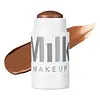What's inside
What's inside
 Key Ingredients
Key Ingredients

 Benefits
Benefits

 Concerns
Concerns

 Ingredients Side-by-side
Ingredients Side-by-side

Ricinus Communis Seed Oil
MaskingC12-15 Alkyl Benzoate
AntimicrobialHelianthus Annuus Seed Oil
EmollientHelianthus Annuus Seed Wax
Skin ConditioningCoconut Alkanes
EmollientSilica
AbrasiveEuphorbia Cerifera Wax
Kaolin
AbrasiveMangifera Indica Seed Butter
Skin ConditioningCitrus Aurantium Dulcis Peel Wax
Skin ConditioningPrunus Armeniaca Kernel Oil
MaskingCoco-Caprylate/Caprate
EmollientBis-Stearyl Dimethicone
EmollientParfum
MaskingHydrogenated Vegetable Oil
EmollientIsopropyl Titanium Triisostearate
EmollientTocopheryl Acetate
AntioxidantSorbitan Tristearate
EmulsifyingCI 77891
Cosmetic ColorantIron Oxides
Ricinus Communis Seed Oil, C12-15 Alkyl Benzoate, Helianthus Annuus Seed Oil, Helianthus Annuus Seed Wax, Coconut Alkanes, Silica, Euphorbia Cerifera Wax, Kaolin, Mangifera Indica Seed Butter, Citrus Aurantium Dulcis Peel Wax, Prunus Armeniaca Kernel Oil, Coco-Caprylate/Caprate, Bis-Stearyl Dimethicone, Parfum, Hydrogenated Vegetable Oil, Isopropyl Titanium Triisostearate, Tocopheryl Acetate, Sorbitan Tristearate, CI 77891, Iron Oxides
Caprylic/Capric Triglyceride
MaskingDiisostearyl Malate
EmollientPolyglyceryl-2 Triisostearate
EmulsifyingPentaerythrityl Tetraisostearate
EmollientSynthetic Wax
AbrasiveHelianthus Annuus Seed Wax
Skin ConditioningSilica
AbrasiveBis-Diglyceryl Polyacyladipate-2
EmollientSynthetic Fluorphlogopite
Ricinus Communis Seed Oil
MaskingHydrogenated Castor Oil
EmollientStearalkonium Hectorite
Gel FormingTocopheryl Acetate
AntioxidantAloe Barbadensis Leaf Extract
EmollientAscorbic Acid
AntioxidantCamellia Sinensis Leaf Extract
AntimicrobialCitrus Limon Fruit Extract
MaskingFragaria Chiloensis Fruit Extract
Skin ConditioningHamamelis Virginiana Extract
AntiseborrhoeicPanax Ginseng Root Extract
EmollientPyrus Malus Fruit Extract
Skin ConditioningRubus Idaeus Fruit Extract
AstringentVaccinium Angustifolium Fruit Extract
Skin ProtectingVitis Vinifera Fruit Extract
Skin ConditioningCaprylyl Glycol
EmollientWater
Skin Conditioning1,2-Hexanediol
Skin ConditioningPhenoxyethanol
PreservativeIron Oxides
Caprylic/Capric Triglyceride, Diisostearyl Malate, Polyglyceryl-2 Triisostearate, Pentaerythrityl Tetraisostearate, Synthetic Wax, Helianthus Annuus Seed Wax, Silica, Bis-Diglyceryl Polyacyladipate-2, Synthetic Fluorphlogopite, Ricinus Communis Seed Oil, Hydrogenated Castor Oil, Stearalkonium Hectorite, Tocopheryl Acetate, Aloe Barbadensis Leaf Extract, Ascorbic Acid, Camellia Sinensis Leaf Extract, Citrus Limon Fruit Extract, Fragaria Chiloensis Fruit Extract, Hamamelis Virginiana Extract, Panax Ginseng Root Extract, Pyrus Malus Fruit Extract, Rubus Idaeus Fruit Extract, Vaccinium Angustifolium Fruit Extract, Vitis Vinifera Fruit Extract, Caprylyl Glycol, Water, 1,2-Hexanediol, Phenoxyethanol, Iron Oxides
 Reviews
Reviews

Alternatives
Ingredients Explained
These ingredients are found in both products.
Ingredients higher up in an ingredient list are typically present in a larger amount.
Helianthus Annuus Seed Wax is created from the common sunflower.
Sunflower seed wax is made up of long chain non-glyceride esters, a small amount of fatty alcohols, and fatty acids.
This ingredient is often used to enhance the texture of products. The fatty acid properties also help hydrate the skin.
Learn more about Helianthus Annuus Seed WaxRicinus Communis Seed Oil is the INCI name for castor oil.
Castor Oil helps moisturize the skin. It is rich in a fatty acid called ricinoleic acid. This fatty acid helps prevent moisture loss on the skin. This helps keep your skin soft and hydrated. Ricinoleic acid also has anti-inflammatory and pain reducing properties.
Besides hydrating the skin, castor oil is also used to hydrate hair. By keeping the hair shaft moisturized, breakage is decreased. More studies are needed to show castor oil's effective on stimulating hair growth.
Castor oil is created by cold-pressing castor seeds and then purifying the oil with heat. It was used in Ancient Egypt as fuel in lamps and to help treat eye irritation.
The term 'fragrance' is not regulated in many countries. In many cases, it is up to the brand to define this term. For instance, many brands choose to label themselves as "fragrance-free" because they are not using synthetic fragrances. However, their products may still contain ingredients such as essential oils that are considered a fragrance.
Learn more about Ricinus Communis Seed OilSilica, also known as silicon dioxide, is a naturally occurring mineral. It is used as a fine, spherical, and porous powder in cosmetics.
Though it has exfoliant properties, the function of silica varies depending on the product.
The unique structure of silica enhances the spreadability and adds smoothness, making it a great texture enhancer.
It is also used as an active carrier, emulsifier, and mattifier due to its ability to absorb excess oil.
In some products, tiny microneedles called spicules are made from silica or hydrolyzed sponge. When you rub them in, they lightly polish away dead skin layers and enhance the penetration of active ingredients.
Learn more about SilicaTocopheryl Acetate is AKA Vitamin E. It is an antioxidant and protects your skin from free radicals. Free radicals damage the skin by breaking down collagen.
One study found using Tocopheryl Acetate with Vitamin C decreased the number of sunburned cells.
Tocopheryl Acetate is commonly found in both skincare and dietary supplements.
Learn more about Tocopheryl AcetateThis ingredient is a combination of red, black, and yellow iron oxide pigments. This combination of colors is usually found in foundation, because it results in a "skin" color.